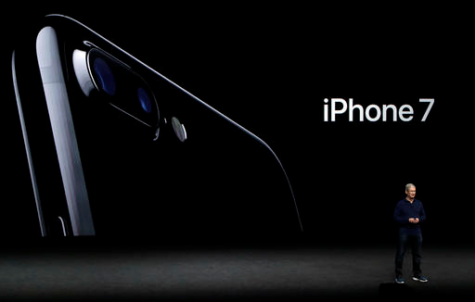Is Apple Still the Best? (Opinion)
March 22, 2017
With yearly improvements to their products unrivalled by their competition, has Samsung pulled ahead of Apple?
Historically, Apple has dominated in the technology industry. Starting with the revolutionary Apple I computer, Apple has been in the lead in the game of innovation. Behind the visionary guidance of Steve Jobs, the company broke boundaries in personal technology. Unfortunately for consumers, those signature innovations that were pioneered by Apple have evaporated in the past few years. The flagship iPhone has seen little change since the 2014 release of the iPhone 6, with the most significant change being the controversial removal of headphone jack. In fact, most changes that have been introduced can be seen as natural technological progressions and not creative inventions.
In 2010, Korean technology magnate, Samsung, entered the mobile market and has released devices yearly. The Samsung Galaxy S and Note lines have embraced the market gaps that Apple left behind and have built upon novel concepts to design their devices. The Note line includes exclusive features such as a built-in smart pen, high resolution displays, and beefy batteries. The Edge line revolutionized curved screens, introducing the concept to a wide audience. In the past few years, it can be clearly seen that Samsung has invested more time and money into advanced technologies, while Apple has chosen to take the “safe route”.
When comparing the iPhone 6S and the iPhone 7, the only change in hardware was a 14% increase in battery power, bringing the battery up to 1,960 milliamp hours (mAH). Even this increase is just 54% of the Samsung Galaxy S7 Edge’s 3,600 mAH. In other words, the S7 had nearly twice as much battery power per full charge. Furthermore, the S7 Edge doubled the iPhone 7’s processing power, managing 4GB of RAM.

One of the changes that Apple made for the iPhone 7 was water resistance. The 7 was the first Apple product to have built-in water resistance. However, Samsung released their Galaxy S5 with complete water resistance in April 2014, nearly two and a half years earlier than the release of the iPhone 7. In this aspect, it can be said that Apple was “catching up” to Samsung.
By far the biggest difference between the iPhone 6S and 7 was the removal of the standard 3.5mm headphone jack. In this case, Apple was trying to recreate the huge innovations that made their brand famous, and according to Forbes, it was a step in the right direction.
The headphone jack is relatively old when it comes to digital technology. It is over 50 years old, and was created in a time when audio signals were mostly analog. The iPhone 7’s lightning port transmits signals digitally, strongly increasing sound quality. Besides this, the practice of cord cutting has become common as companies imagine a wireless future. By promoting wireless headsets, Apple is pushing the industry towards the future.
This monumental step forward still exhibited Apple’s isolationist attitude, however. While most other portable technologies use a micro-USB port for charging, Apple has consistently refused to use this cable, claiming that the lightning cable and its predecessors have superior ability. Unfortunately, Apple is only harming the industry with the lightning cable.
The Samsung Galaxy S6 generation of phones came with Quick Charge micro-USB chargers that could charge bigger Samsung batteries faster than lightning cables could charge the same generation of iPhones. On top of this, Samsung has embraced wireless charging, which takes Apple’s cord-cutting to a new level. By refusing to join the majority of other companies and use the standard micro-USB, Apple is pulling the entire industry backwards from an inevitable future of a universal charging cable.
In addition to superior hardware and compatibility, Samsung has also recently beaten Apple in the design game. The LG Flex first introduced a curved display, although the screen was mostly a gimmick that offered no new features or significance. The Samsung Edge and Note lines greatly improved this concept, equipping their side panels with plenty of features not before seen on phones. Note series phones also include a smart pen, something that Apple decided to release separately for a whopping $100.
The flagship iPhone has not received a significant design recreation since the introduction of the iPhone 6 in September 2014, but yearly releases continue to sell for prices too high for their underwhelming performance.
So if Samsung phones dominate Apple’s phones in both hardware, software, and design, why does Apple still lead Samsung in market share? According to Time, a big reason for this is Apple’s simplicity. Nearly every iteration of Apple’s operating system iOS has been praised for its user-friendliness, something that Android OS definitely lacks.
Another reason for their continued success could be their brand. From the Apple II computer in 1977 to the first iPhone in 2007, Apple has broken down industry walls. Because of their historically trailblazing nature, Apple has built up the perception that every new product is just as revolutionary as the last, however inaccurate that may actually be. This in turn creates a demand for the “next big thing” pushing Apple higher and higher.
Meanwhile, Samsung is attempting to recover from its slow start. Early S-line phones are objectively worse than their Apple counterparts, made with flimsy parts, bad screens and worse cameras. This negative perception has hindered Samsung in a way that the company may never recover from. Why would a customer even consider buying something if they think that it’s worse?
Unfortunately, little to nothing can be done to sway the mobile market. Consumers will always have personal biases and reasons for choosing something over another. Showing people their options, and explaining in which ways some things are better or worse than others can change someone’s opinion. Doing research is always essential when making any decision, especially when it comes to a device that will rarely leave one’s side.





